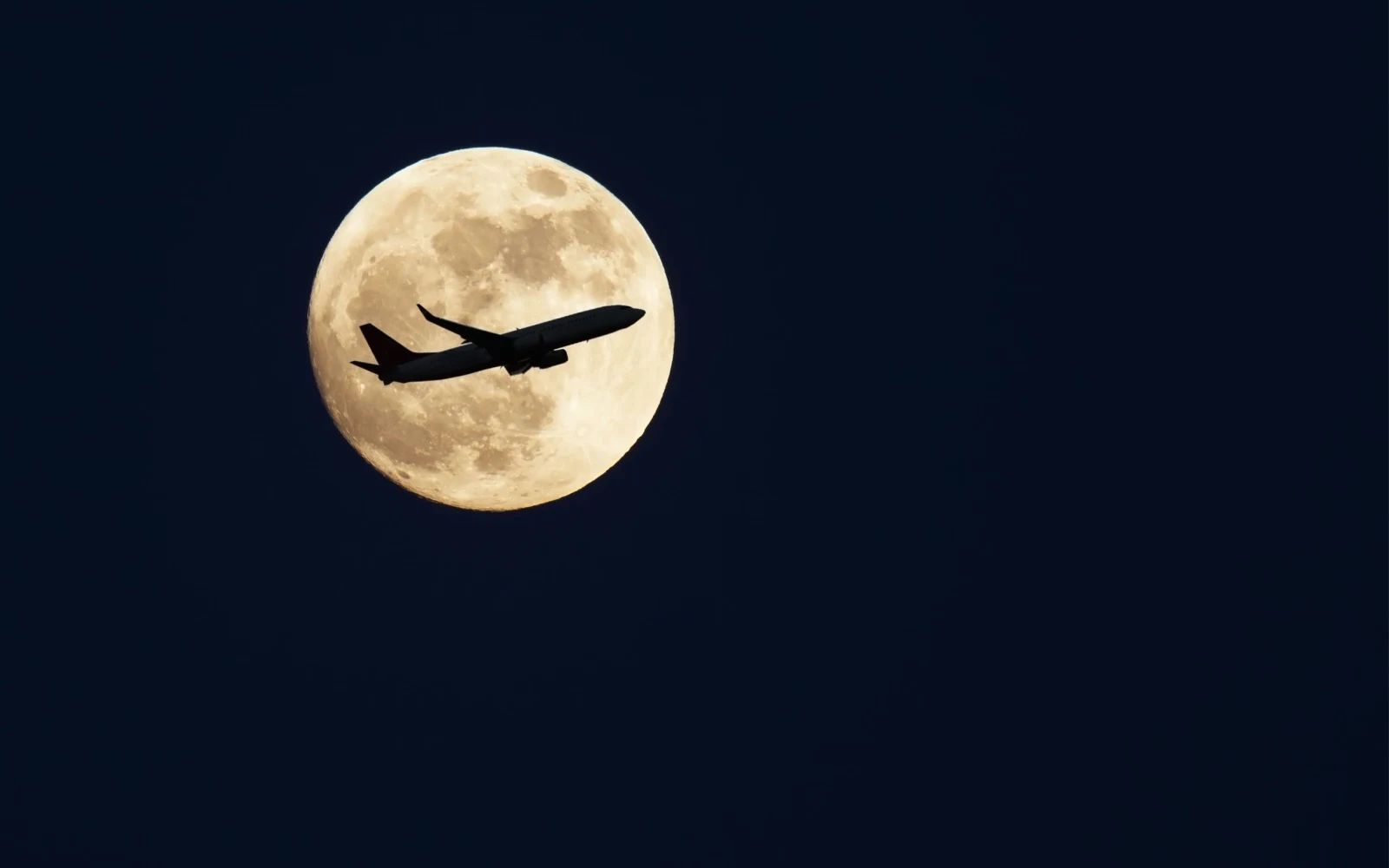You’ve probably heard the term used by seasoned travelers, but what is a red eye flight? These long haul flights aren’t for the faint of heart, but may save you money and make it easier to snag the best seat on the plane.
Let’s dig into the definition of red eye flights along with pros and cons to consider before you book one!
What Is a Red Eye Flight?
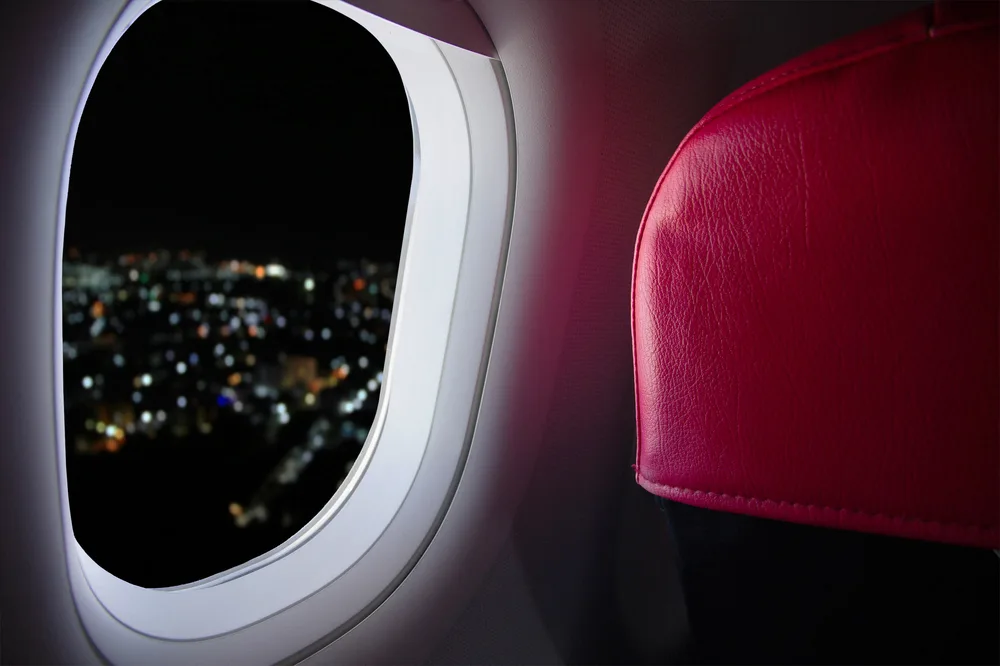
pisitnamtasaeng/Shutterstock
A red eye flight is an overnight flight that departs anywhere from 9:00PM to 1:00AM and lands in the early morning around 5:00AM to 7:00AM.
These long flights transport passengers to distant or remote cities and destinations that take several hours to reach. Common red eye flights operate between the East and West Coasts of the United States, between the US and Europe, and between US and South America.
People might say they’re “taking the red eye” to a certain city or country. What they mean is that they’re taking an overnight flight that won’t arrive until the morning.
Red eye flights are known to be fatigue-inducing for travelers. Because they take place when most people are usually sound asleep, they can throw sleep patterns out of whack and leave passengers feeling drained.
These overnight flights really exploded in popularity in the 1980s and 1990s when business air travel hit record highs.
Corporate employees wanted as much time with prospects and teams as possible, so they chose red eye flights to avoid letting travel cut into their face time.
Today, red eye flights are still budget-friendly routes that can be a good option for travelers who don’t mind sacrificing a little shut-eye in the name of saving money or taking a less-crowded flight.
Where Does the Term Red Eye Flight Come From?
Since these flights take place overnight and don’t land until the morning, passengers may struggle to get enough (or any) sleep on the flight and appear red-eyed as a result.
That’s where the term red eye flight comes from, but you might be surprised that it didn’t come into usage regarding planes until 1969. In 1969, American Airlines started advertising red eye flights once airplane navigation capabilities were strong enough for overnight flights.
Delta Air Lines swooped in soon after, making use of their planes that had been sitting overnight and generating an entirely new revenue stream.
Passengers appreciated the convenience and cheaper fares of the red eye flights, so the concept stuck around. We still call them red eye flights today!
Red Eye Flight Pros and Cons
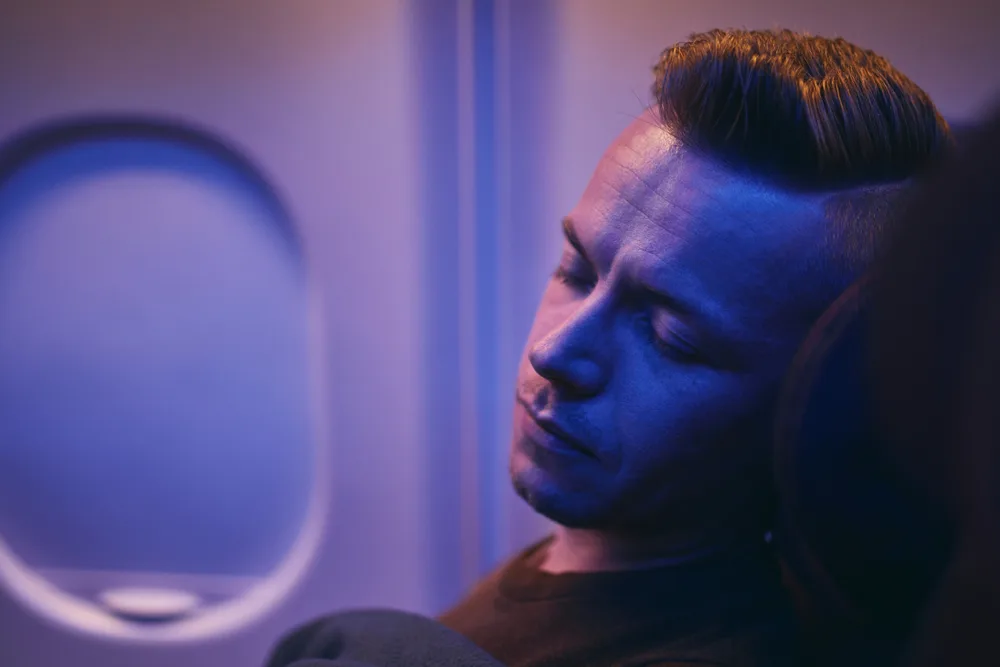
Jaromir Chalabala/Shutterstock
Red eye flights may have a poor reputation (it’s the name, isn’t it?), but as with most things in life, there are pros and cons to consider here. For some people, red eye flights might be the perfect solution. For others, they could be a nightmare.
The trick is figuring out which camp you fall into before you book your overnight flight. Red eye flights come with a few strong benefits and some disadvantages, so let’s take a look at the pros and cons you should keep in mind.
Pros
These late-night flights can be a great option if you’re looking for a budget-friendly, less-crowded flight where you can really stretch your legs.
- Cheaper: Catching the red eye to your destination might mean saving a few bucks on your airfare, but don’t count on it being a huge savings. Fares from L.A. to NYC in our test search were about $10 cheaper overnight.
- Less crowded: It’s easy to see how a late-night flight would attract fewer passengers, leading to a less-crowded flight (and fewer people at the airport in general).
- Sleep while you fly: If you’re the type that can sleep anywhere, you can board the plane, get some rest, and wake up when you land at your destination. Talk about a traveler’s dream!
- Save on hotel costs: If you arrived at your destination in the afternoon or evening, you’d have to pay for an extra night in your hotel. With red eye flights, you’ll save on hotel costs by flying through the night.
- Better seat selection: With fewer passengers on the plane for these overnight flights, you’ll have better seat selection (whether seats are assigned or not).
Cons
You might want to avoid booking a red eye flight if you’re susceptible to jet lag, want a wide flight selection, or are traveling with kids.
- Jet lag: Ask anyone who’s flown a red eye route: It’s exhausting and really does a number on your circadian rhythm. If you arrive jet lagged, it’ll take some time to recover before you can enjoy your destination.
- Fewer flight options: Booking flights that take place overnight leaves you with fewer options to get from point A to point B. If you’re hoping to pick from a wide range of flight options, red eyes won’t be for you.
- Tough to travel with kids: Bringing the whole fam — or just your slew o’ kids — probably isn’t the ideal situation for booking a red eye plane ride. You may all be able to catch a few winks during the flight, but it can be noisy, kids will need to use the bathroom, deplaning will be a chore, and everyone will need to sleep in once you arrive to recover.
- Uncomfortable for sleeping: Even the puffiest, softest neck pillow isn’t enough to make up for the discomfort that is attempting to sleep on a plane as you fly through the night. Engine noise, other passengers, the flight crew, announcements, and the general unease of piloting through the air in the pitch black can all mean sleep is but a pipe dream on a red eye.
Things to Consider
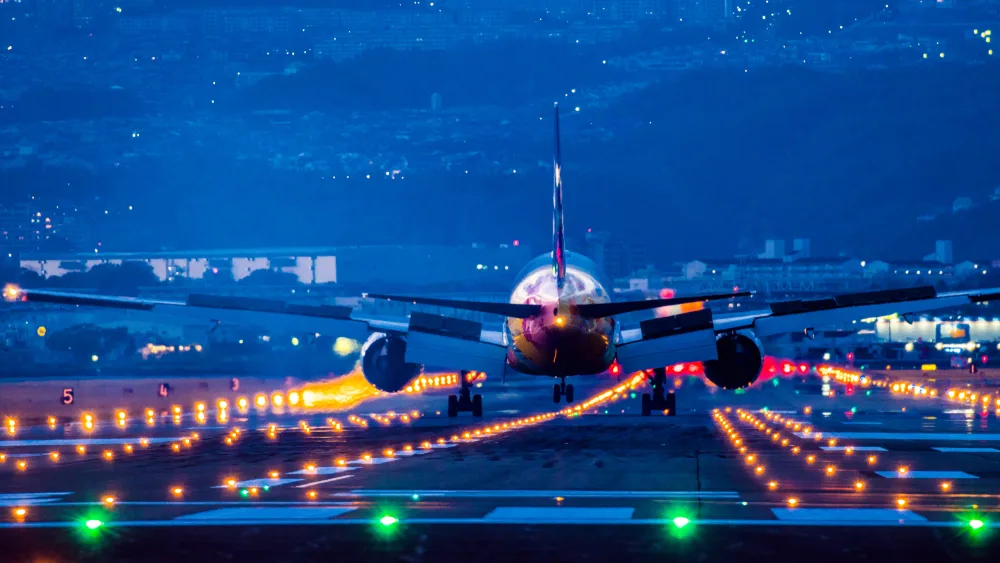
beeboys/Shutterstock
If you’re still hanging in there and considering booking the next red eye to your destination, we applaud you. It’s not for everyone, but it can be a great option in some cases!
Still, you don’t know the full story and what to expect until you’ve read through these additional considerations:
- Red eyes aren’t any shorter than daytime flights. We looked at flight times between Los Angeles and New York City, which took about 5 hours and 30 minutes regardless of the time of day. If you’re thinking about booking one just to save time, know that you won’t get to your destination any faster this way.
- Cheaper, but only by a few bucks. Saving money can be major savings or just shaving off a few bucks here and there. While opting for a red eye over a regular flight won’t save you big bucks, it can be around $10 cheaper than daytime or earlier evening flights. Where you’ll really save big is on the hotel rate you won’t have to pay as you’re traveling overnight! Consider how much you want to save and what you’re willing to trade off for the slightly-cheaper airfare.
- It’s your chance to stretch out. If you’ve ever scowled at the filled airplane seat next to you and wished it were empty, a red eye flight may be your chance to make your dreams come true. With fewer passengers onboard these late night flights, you may find yourself with an empty seat or an entirely empty row to yourself!
- Pack the essentials. If you’ll be flying overnight, you should bring a sleep mask, noise-cancelling earbuds, a soft neck pillow, and a lightweight blanket to help yourself get comfy for the flight. You may not get the best sleep ever, but you’ll be able to rest and stave off the storied red eyes in the morning this way.
- It’s worth trying once. There’s something kind of edgy and fun about the idea of taking the red eye to your destination. Maybe it’s the depiction in movies and books, but it feels like a rite of passage for travelers. If you can stand it, it might be worth taking the red eye at least once — just to say you did it.
Frequently Asked Questions
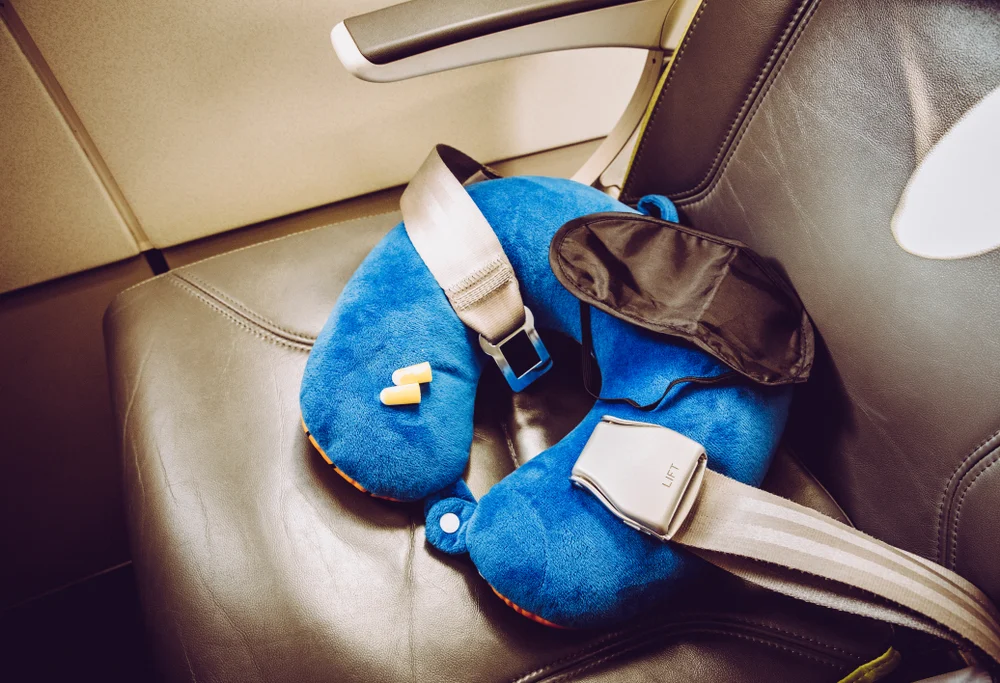
FotoHelin/Shutterstock
If you think you might find yourself on the flight manifest for a future red eye, check out the most frequently asked questions below to learn more.
What is considered a red-eye flight?
Red-eye flights are overnight flights that typically take off between 9PM-1AM and land between 5AM-7AM.
Red eye flights are named for the tell-tale red eyes that weary, sleep-deprived travelers have upon landing in the morning.
Is a red-eye flight cheaper?
Red-eye flights can be slightly cheaper than earlier flights, but we only found differences around $10 for these late-night flights.
Where travelers save the most money is on hotel costs without needing to pay for a room on the night of the flight.
Why do people take red eye flights?
People may take red eye flights to have more time enjoying their destination without cutting into the daytime hours to travel.
Red eye flights can be slightly cheaper, less crowded, and offer better seat selection as well.
Are red eye flights usually full?
Red eye flights don’t fill up as quickly as daytime and evening flights because many people want to avoid flying overnight.
With fewer passengers on the plane, you may have better seat availability and open seats around you for a more comfortable flight.
Should you sleep after a red-eye flight?
You should try to sleep after a red-eye flight to help your body acclimate to the new time zone and to stave off jet lag.
If you weren’t able to snooze during the overnight flight, a few hours of sleep can help you reset and enjoy your trip much more than you would feeling jet lagged and exhausted.
So, What Is a Red Eye Flight?
If you book a flight that takes off in the late evening (from 9:00PM to 1:00AM) and lands in the early morning (between 5:00AM and 7:00AM), then you, my friend, will be taking a red eye flight.
Red eye flights, or overnight flights, are not for the faint of heart. Taking one means you’ll be flying for 5+ hours, traveling into a different time zone (hello, jet lag), and arriving at your destination with an insatiable desire for a long nap.
They can be cheaper, less crowded, and give you the best seat options on the plane. But it’s hard to sleep on these flights, you may wake up with the tell-tale red eyes, and you might not save as much as you think.
If you want to strike another entry off your travel bucket list, by all means, book the next red eye. But if shut-eye is more your thing, we say stick with daytime flights.



